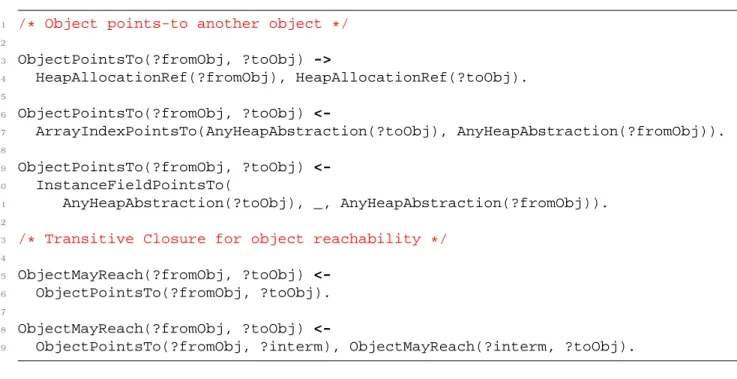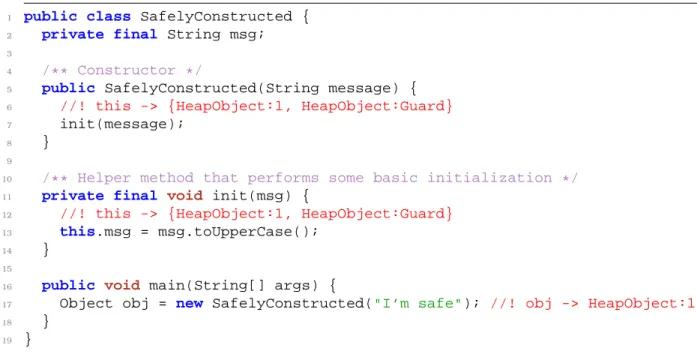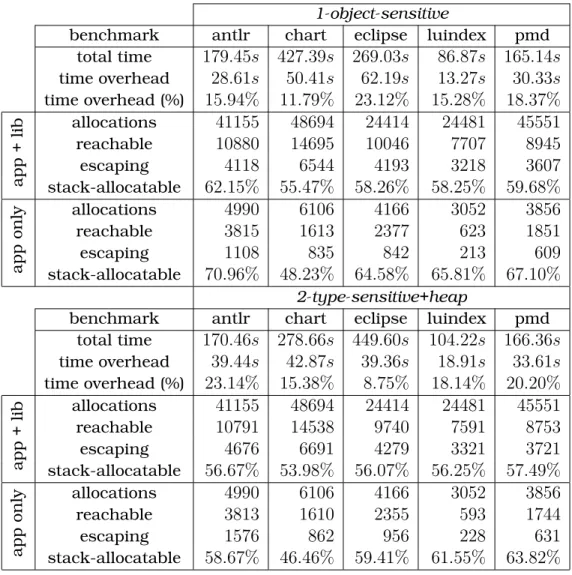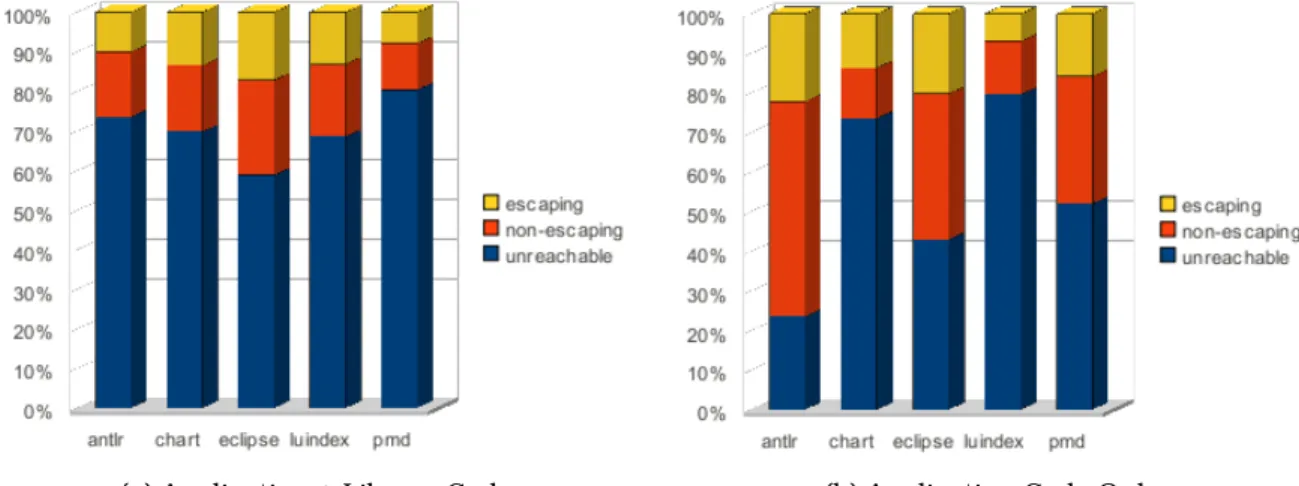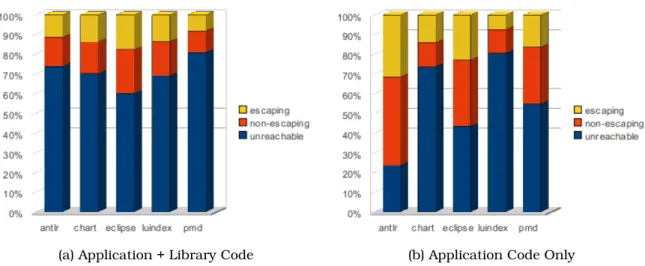We present a declarative escape analysis of an entire Java program, written entirely in Datalog, that zooms in on the escapeable objects in the program. Our analysis is part of the Doop framework [3], which provides it with point-to-point analysis of many possible context types. The main intuition is that an object escapes if it is reachable via a static field, an exception, or a local variable of the direct caller of the method that created it.
The escape analysis required only about 100 lines of Datalog code, which clearly demonstrates the power of the declarative approach to static analysis. This allowed us to focus on the definition of escaped objects and leave their calculation to the underlying Datalog engine, which resulted in a concise and expressive rendering. By running the escape analysis for a variety of possible contexts, we found that the choice of context has little effect on accuracy, but is crucial to the overall execution time.
His valuable insights and extensive knowledge about the field of static analysis were crucial throughout the research for and writing of this thesis.
Preface
Introduction
Escape analysis should not be confused with thread escape analysis, where a heap object is said to escape when it can be accessed from more than one thread. Escape analysis can be used as a compiler optimization, where heap allocations for non-escaping objects can be converted to stack allocations. In error detection, accuracy is of the utmost importance, and thus whole-program escape analysis is a very good candidate due to its high accuracy that minimizes false positives of escaped objects.
Therefore, our escape analysis can run with any possible context supported by Doop and extended with any future client analysis for this framework. We test different choices of context for escape analysis and compare them in terms of precision and time overhead. We discuss a technique based on escape analysis to identify cases of unsafe disclosure.
Background
- Points-To Analysis in Datalog
A static abstraction of the heap object is captured in variable ?heap - it can be concretely represented as, for example, a fully qualified class name and the allocation's bytecode instruction index. The Datalog program consists of a series of rules that are used to establish facts about derived relationships (such as VarPointsTo, which is the point-to relationship, i.e. it associates each program variable, ?var, with each heap object abstraction, ?heap , can it point to) from a composite of previously established facts. In the LB-Datalog syntax, the left arrow symbol (<-) separates the inferred fact (ie the head of the rule) from the previously established facts (ie the body of the rule).
Note the base case of the calculation above (line 1), as well as the recursion in the definition of VarPointsTo(line 2). The key to a precise point-to-point analysis is context sensitivity, which consists of qualifying program variables (and possibly object abstractions - in which case the context-sensitive analysis is also said to have a context-sensitive heap) with context information : the analysis wraps information together (eg, ''which objects this method argument can point to'') over all possible executions leading to the same context, while separating all information for different contexts. They differ in the contexts of a context, as well as in when contexts are created and updated.
Here we will not yet concern ourselves with such differences - at this point it is sufficient to know that a context-sensitive analysis qualifies its calculated facts with additional information. Context-sensitive parsing in Doop is largely similar to the above context-sensitive logic. The main changes are due to the introduction of Datalog variables, which represent contexts for variables (and, in the case of a context-sensitive heap, also objects), in the analyzed program.
For an illustrative example, the following two rules treat method calls as implicit assignments from a method's actual parameters to formal parameters, in a 1-context-sensitive analysis with a context-insensitive heap. Note that some of the above relations are functions, in which case the functional notation "Relation[?domainvar] = ?val" is used instead of the traditional relational notation. In [3], Martin Bravenboer and Yannis Smaragdakis demonstrate a great example of logic for casting control in Java - i.e., answering the question "can type A be cast to type B?".
A small excerpt with the text of the Java language specification included in the comments can be seen in Figure 2.1.

Over-Approximating Escaped Objects
- The Immediate Callers Conjecture
- Object Reachability
- Static Fields
- Handling of Exceptions
- Putting Everything Together
- Synthesis
- Optimizations
That is, if an object cannot be reached by any of the direct callers of the method that allocated it, it will not be accessible by other indirect callers (i.e. all the methods that can make up the call stack up to m1) and therefore will not escape. If the call graph contains cycles, it is possible that an object will be reachable by some of the indirect callers that may also be called bym1 (thus forming a cycle) and not reachable by all of its direct callers. As will become clear later in Chapter 5, the size of InstanceFieldPointsTo is the bottleneck in escape parsing, and so context sensitivity, even in this limited form, is critical to the effectiveness of escape parsing.
Apart from local variables in the activation stack (i.e. the per-thread Java virtual machine stack that adds and removes frames every time a method is called and completes its respective specifications. Therefore, any heap object reachable from such a variable at any given time must The treatment of this case is analogous to that of Section 3.3, where the basis of the recursion is now the relationThrowPointsTo (Figure 3.5).
The MethodsThatMayReference relation contains a (?obj, ?method)pair if method?meth defines a variable?var that can point to object?obj (Figure 3.6, lines 13-19). Therefore, its arguments (eg ?toObj, ?callee) will be bound to the heap object and the method that allocated it. Using the Reachable(lines) relation is an optimization that restricts escape analysis to reachable methods.
Therefore, the objects that can be escaped are a subset of the objects that can be reached (ie, the objects allocated in methods that can be reached). Appendix A contains the entire code for the escape analysis presented in this chapter, including some additional optimizations specific to the LogicBlox engine [3], which are beyond the scope of this thesis. The fact that in about 100 lines of code we were able to express a powerful escape analysis shows how expressive Datalog is and how suitable an environment for developing static analysis.
The escape analysis can be added on top of any point-to-point analysis, with no code changes required.

Safe Publication
- Setup
- Evaluation
- Related Work
- Conclusions
This chapter presents an evaluation of escape analysis on a well-known benchmark package and experimental results. We focused on a subset of DaCapo benchmarks, namely theantlr, chart, eclipse, luindex, and pmd, all of which can be successfully analyzed by the Doop framework with reflection analysis enabled. The "time cost" is the additional times required by the escape analysis, while the "total time" is the sum of the escape analysis time and the basic analysis time performed by Doop.
The percentage of reachable objects that can be safely allocated in the stack ranges from 46% to 70%. There was an upper bound for the execution time of the escape analysis equal to twice. The reason for these timeouts is that the execution time of the escape analysis is dominated by the computation of object reachability, which in turn depends heavily on the size of the InstanceFieldPointsTo relationship (since the size of ArrayIndexPointsTo is relatively is small). .
With the exception of the 2type+1H analysis, there is little variation on the percentage of escaped objects on the range of for application plus library code, and for just application code. By using Datalog for static whole-program escape analysis we are able to obtain an expressive, concise and scalable algorithm, while our analysis can be easily leveraged by any other part of the Doop framework and extended in any possible way with little or no effort. In contrast, our work achieves better results, on average, with much smaller variation for different benchmark programs than any of the aforementioned techniques [4, 26, 1].
Fr´ed´eric Vivien and Martin Rinard have taken a step-by-step approach rather than a whole-program analysis, which focuses only on the parts of the program that can produce useful results [23]. However, in other cases, such as in debugging tools where the accuracy of the reported results is of paramount importance and the complete code is almost always available, analysis of the whole program is much more promising. Using Datalog, we were able to succinctly express a program-wide declarative escape analysis for Java, identifying on average 60.66% of application heap allocation sites and 57.43% of all allocation sites (i.e. including library code). , from the DaCapo benchmark programs as non-escaping and thus safe candidates to be assigned to the stack.
The escape analysis, in its final optimized version, required only about 100 lines of Datalog code, clearly demonstrating the power of the declarative approach for static analysis. The escape analysis was built on top of the Baptism framework [3] which enabled the convenient decoupling of the choice of context from the escape analysis code. We believe that in any context where it is reasonable to assume that the bulk of the code base is available, our whole-program escape analysis is an efficient and highly accurate candidate.
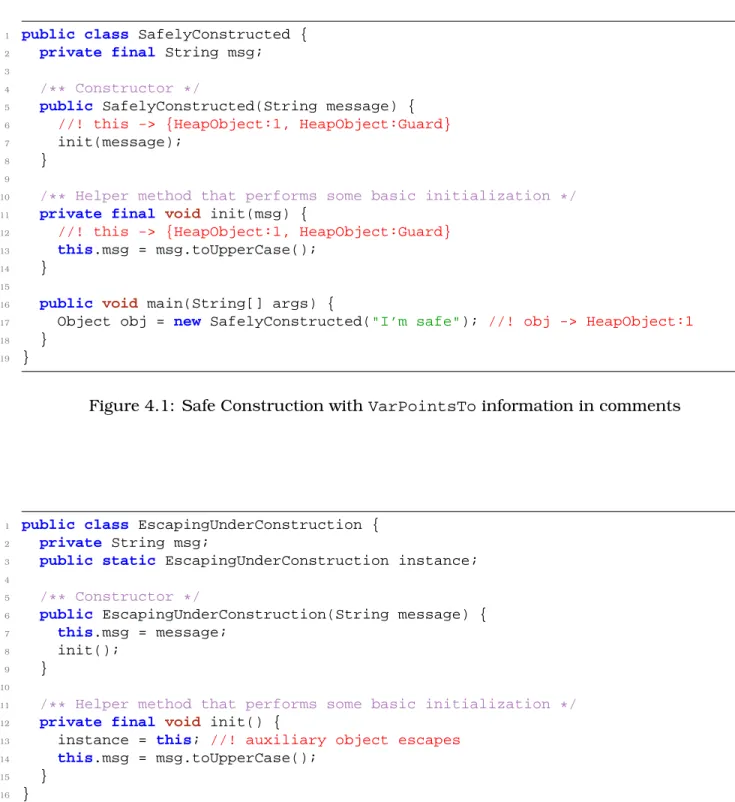
Acronyms and Abbreviations
Appendix A
Escape Analysis Code
